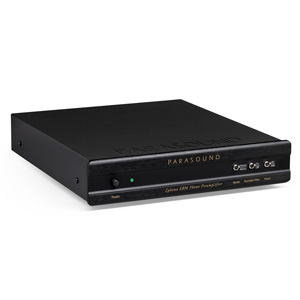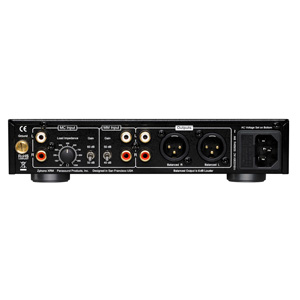| |


Experience the Full Emotional Content of Your Vinyl
The Zphono XRM is Parasound’s latest phono preamplifier. It combines high performance with unprecedented versatility at a price that fills the gap between Parasound's popular $200 Zphono and the internationally acclaimed $1,495 Halo JC 3 Jr. Parasound built the Zphono XRM for vinyl lovers who are willing to spend $1,000 to $1,500 to upgrade their entry-level turntable/cartridge, but who are not interested in spending $800 or more to upgrade their phono preamp.
Most phono preamps don’t give buyers what they really want. The Parasound Zphono XRM delivers this must-have list and more! It offers convenient on-the-fly impedance adjustment for MC cartridges, a switchable rumble filter, a stereo-mono switch and balanced XLR outputs. Additionally, many phono preamps use 'wall warts' external power supply that can add noise to the audio signal. Zphono XRM uses a far superior high-capacity, low-noise, linear power supply that won't compromise your music.
The XRM gives you, the listener, the best possible opportunity to experience the full emotional content of vinyl. Independent circuits for MM and MC optimize the signal to noise ratio and sonic presentation. Balanced XLR outputs provide optimum rejection of external noise using common mode rejection (CMRR).
The is One Serious Phono Stage
The Zphono XRM uses an ultra-low distortion design (<0.02% THD) with ultra high-speed, low-noise op amps plus audiophile grade resistors and capacitors. It is RIAA accurate to within 0.2 dB. Input and output RCA jacks are gold plated. The unique half-rack width chassis (one rack space high) makes the XRM easy to place, especially in custom installations. But don't let the compact dimensions fool you. This is one serious phono stage. The XRM is powerful proof of Parasound’s continuing support of the vinyl renaissance.
Two Turntable Input Jacks
The Zphono XRM has separate input jacks and circuitry for MM (moving magnet) and MC (moving coil) cartridges. Connect your turntable’s signal cables to the Input jacks on the Zphono XRM that correspond to the type of cartridge you are using. You can connect two turntables simultaneously if one turntable has an MC cartridge and the other turntable has an MM cartridge. You can also use a turntable with two tonearms, provided one is equipped with an MC cartridge and the other with an MM cartridge. The front panel input select switch makes it easy to toggle back and forth between your MM and MC connection.
Balanced and Unbalanced Output Connections
The Zphono XRM Output jacks connect to the line level input jacks on your line stage preamplifier, integrated amplifier or receiver. Both balanced XLR and unbalanced RCA output jacks are provided. If your preamplifier, integrated amp or receiver is equipped with balanced XLR inputs we recommend using the Zphono XRM Balanced XLR output jacks for the maximum rejection of external noise. The balanced and unbalanced jacks are active simultaneously.
On-the-Fly MC Input Impedance Adjustment
The Zphono XRM’s impedance adjust knob allows you to fine tune the input impedance for MC cartridges over a range of 50 ohms to 1050 ohms. Cartridge manufacturers recommend what they consider to be an optimal load impedance. However, their published specification won’t necessarily give you the best results in your system. The design of the XRM lets you experiment with the MC impedance control on-the-fly while you are listening to music and ultimately use whichever load setting you feel results in the best performance of your system.
MC and MM Cartridge Gain Options
MC and MM phono cartridge gain options let you select the appropriate gain for your cartridge. The most typical settings are 40 dB for MM and 60 dB for MC. This is a good place to start, but you may want to experiment to see what sounds best in your system. (We suggest turning off the Zphono XRM before making gain changes to prevent an audible "pop" noise.
MC Gain Options consist of 50dB for high output moving coil cartridges and 60dB for low output moving coil cartridges whose output is less than 0.5mV. MM Gain Options consist of 40dB for most moving magnet cartridges and 50dB for low output moving magnet cartridges.
Rumble Filter Switch
The Zphono XRM's rumble filter switch reduces audio output below 40Hz. This switch is especially useful if your turntable is susceptible to feedback from your speakers and subwoofer, or if you hear footsteps when you walk near the turntable. Some older records may also be pressed with audible rumble. If you are hearing low frequency rumble in your speakers, this filter will help reduce it.
Stereo/Mono Mode Switch
A nice feature of the XRM which you don't usually find in phono preamps in its price range is a stereo/mono mode switch. Selecting Mono parallels the left and right stereo channels into mono. Why would you want to do this? Many older mono records and some older stereo records might sound cleaner when you select mono. (The normal position is Stereo.)
- Dual inputs for two turntables (1 MM & 1 MC)
- Front panel input select switch
- Front panel mono/stereo mode switch
- Front panel rumble filter switch
- Balanced and unbalanced outputs
- Variable MC impedance adjustment of 50-1050 ohms
- MM Gain options of 40 dB or 50 dB unbalanced (46 dB/56 dB balanced)
- MC Gain options of 50 dB or 60 dB unbalanced (56 dB/66 dB balanced)
- RIAA accurate to within 0.2 dB
- Ultra-low distortion (<0.02% THD)
- Ultra high-speed, low-noise op amps
- Audiophile grade resistors and capacitors
- Gold-plated RCA input and output jacks
- Unique half-rack width chassis; 1 rack space high
Frequency Response
• 20-20 kHz, +/- 0.2 dB
Total Harmonic Distortion
• 0.02% at 1 kHz
Signal to Noise Ratio, MM 40 dB Setting
• > 94 dB, input shorted, IHF A-weighted
• > 90 dB, input shorted, unweighted]
Signal to Noise Ratio, MM 50 dB Setting
• > 94 dB, input shorted, IHF A-weighted
• > 90 dB, input shorted, unweighted
Signal to Noise Ratio, MC 50 dB Setting
• > 92 dB, input shorted, IHF A-weighted
• > 88 dB, input shorted, unweighted
Signal to Noise Ratio, MC 60 dB Setting
• > 82 dB, input shorted, IHF A-weighted
• > 80 dB, input shorted, unweighted
Inter-channel Crosstalk
• > 80 dB at 1 kHz
Input Impedance
• MM: 47k O
• MC: 50-1050 O
Output Impedance
• Unbalanced: 150 O
• Balanced: 150 O per leg
Input Sensitivity at 1 kHz, 4mV Input
• 40 dB: 5 mV for 500mV output
• 50 dB: 5 mV for 1.5 Volts output
• 60 dB: 5 mV for 3 Volts output
Input Sensitivity at 1 kHz, 1V Output
• 40 dB: 10 mV for 1.0 Volt output
• 50 dB: 3.5 mV for 1.0 Volt output
• 60 dB: 1.8 mV for 1.0 Volt output
Total Gain
• 40 dB / 50 dB / 60 dB (unbalanced output)
• 46 dB / 56 dB / 66 dB (balanced output)
Rumble Filter
• 40 Hz high pass, 18 dB /oct.
AC Power Requirement
• Standby: 0 watts
• Power On: 7 watts
• 115 VAC or 230 VAC 50 - 60 Hz (Selected on bottom)
Dimensions
• Width: 8.5” (220 mm)
• Depth: 10” (254 mm)
• Depth: 12” (305 mm) - cables connected
• Height, with feet: 2” (51 mm)
• Height, without feet: 1.75” (45 mm), 1U
Weight
• Net: 3.9 lbs. (1.8kg)
|
|
|



